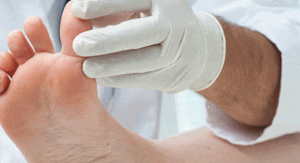Diabetic Foot Infections and Preventing Amputation
June 10 2021
The prevalence of diabetes in the Unites States continues rising at an alarming rate. According to the CDC an estimated 30.3 million people have been diagnosed with diabetes and is expected to exceed half a billion by 2030. It’s estimated that 7.2 million adults are undiagnosed in the United States. With this increasing trend of diabetes, comes a rise in lower extremity amputations. The majority of these lower extremity amputations are in fact preventable. Unfortunately, a large portion of the diabetic population are not receiving proper preventative foot care or performing daily steps to prevent infections and/or amputation.
The first step is determining if you have diabetes. Diabetes can easily be diagnosed by seeing you  primary care physician and completing some blood work. Once diagnosed with diabetes routine follow up with your PCP is imperative to have your blood sugars under control. Diabetes can be managed with diet modifications, weight loss and medication if needed. Next, is finding a podiatrist for routine care who can also educate you on preventative measures. Regular foot screenings can be lifesaving and limb saving for the diabetic population. Your Podiatrist will also screen you for other risk factors that can contribute to the development of diabetic foot infections and/or amputations. The good news is that many of these risk factors are preventable or controllable. Some common risk factors include high blood sugars, high blood pressure, smoking, callouses/corns, foot deformity, poor blood flow, history of ulcers or previous amputations, vision loss, kidney disease and neuropathy. Working together with you, your PCP and other medical professionals, we can significantly reduce your risk of amputation.
primary care physician and completing some blood work. Once diagnosed with diabetes routine follow up with your PCP is imperative to have your blood sugars under control. Diabetes can be managed with diet modifications, weight loss and medication if needed. Next, is finding a podiatrist for routine care who can also educate you on preventative measures. Regular foot screenings can be lifesaving and limb saving for the diabetic population. Your Podiatrist will also screen you for other risk factors that can contribute to the development of diabetic foot infections and/or amputations. The good news is that many of these risk factors are preventable or controllable. Some common risk factors include high blood sugars, high blood pressure, smoking, callouses/corns, foot deformity, poor blood flow, history of ulcers or previous amputations, vision loss, kidney disease and neuropathy. Working together with you, your PCP and other medical professionals, we can significantly reduce your risk of amputation.
Ulcers are a primary cause leading to the development of complicated foot infections, hospitalization and amputation. Many of these ulcers start as a simple callous. As a diabetic with some degree of neuropathy, you may not feel a callous progressing into an open wound. You may also not notice early signs of infection. Without prompt treatment, this unnoticed wound or infection can quickly deepen to the level of bone or progress to a limb threatening infection requiring hospitalization and likely amputation. This is why routine foot screenings are so important for the diabetic population.
and amputation. Many of these ulcers start as a simple callous. As a diabetic with some degree of neuropathy, you may not feel a callous progressing into an open wound. You may also not notice early signs of infection. Without prompt treatment, this unnoticed wound or infection can quickly deepen to the level of bone or progress to a limb threatening infection requiring hospitalization and likely amputation. This is why routine foot screenings are so important for the diabetic population.
In addition to routine foot screenings, self-inspection should be performed daily. Check your feet daily for blisters, cuts, sores, redness, swelling or any other abnormal changes. Make sure to also look between your toes. Use white socks, white socks make it easier to notice blood or drainage. This will help you notice that something is wrong. You also want to wear socks that hold moisture away from the skin like cotton or special acrylic fibers, not nylon. Avoid socks with seams that irritate your skin. You can also turn your socks inside out, so the seam is on directly on your skin. If you can’t reach your feet, ask someone to help or try using a foot mirror. Don’t try to remove calluses or other foot lesion yourself. Avoid going barefoot. Don’t use worn down shoes, shoes that are too small or too narrow for your foot. Don’t smoke or quit smoking if you do, smoking impair circulation. If you notice anything abnormal, contact your podiatrist right away or other medical provider. Also, make sure to attend your routine foot screenings when scheduled as well as follow-ups with your PCP or medical provided. Together, we can changes lives by saving limbs.
 Family Foot and Leg Center has several Centers from Collier, Lee, & Charlotte Counties to quickly resolve all your foot and ankle problems.
Family Foot and Leg Center has several Centers from Collier, Lee, & Charlotte Counties to quickly resolve all your foot and ankle problems.
Isin A. Mustafa, DPM,MSHS, AACFAS
Phone: (239) 430-3668
3161 Harbor BLVD, suite B
Port Charlotte, FL
—————–


 Tel: 239-430-3668
Tel: 239-430-3668